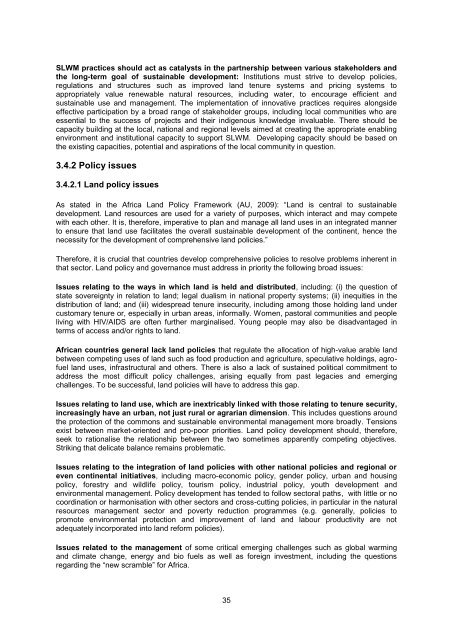The CAADP Pillar I Framework
The CAADP Pillar I Framework
The CAADP Pillar I Framework
- No tags were found...
Create successful ePaper yourself
Turn your PDF publications into a flip-book with our unique Google optimized e-Paper software.
SLWM practices should act as catalysts in the partnership between various stakeholders andthe long-term goal of sustainable development: Institutions must strive to develop policies,regulations and structures such as improved land tenure systems and pricing systems toappropriately value renewable natural resources, including water, to encourage efficient andsustainable use and management. <strong>The</strong> implementation of innovative practices requires alongsideeffective participation by a broad range of stakeholder groups, including local communities who areessential to the success of projects and their indigenous knowledge invaluable. <strong>The</strong>re should becapacity building at the local, national and regional levels aimed at creating the appropriate enablingenvironment and institutional capacity to support SLWM. Developing capacity should be based onthe existing capacities, potential and aspirations of the local community in question.3.4.2 Policy issues3.4.2.1 Land policy issuesAs stated in the Africa Land Policy <strong>Framework</strong> (AU, 2009): ―Land is central to sustainabledevelopment. Land resources are used for a variety of purposes, which interact and may competewith each other. It is, therefore, imperative to plan and manage all land uses in an integrated mannerto ensure that land use facilitates the overall sustainable development of the continent, hence thenecessity for the development of comprehensive land policies.‖<strong>The</strong>refore, it is crucial that countries develop comprehensive policies to resolve problems inherent inthat sector. Land policy and governance must address in priority the following broad issues:Issues relating to the ways in which land is held and distributed, including: (i) the question ofstate sovereignty in relation to land; legal dualism in national property systems; (ii) inequities in thedistribution of land; and (iii) widespread tenure insecurity, including among those holding land undercustomary tenure or, especially in urban areas, informally. Women, pastoral communities and peopleliving with HIV/AIDS are often further marginalised. Young people may also be disadvantaged interms of access and/or rights to land.African countries general lack land policies that regulate the allocation of high-value arable landbetween competing uses of land such as food production and agriculture, speculative holdings, agrofuelland uses, infrastructural and others. <strong>The</strong>re is also a lack of sustained political commitment toaddress the most difficult policy challenges, arising equally from past legacies and emergingchallenges. To be successful, land policies will have to address this gap.Issues relating to land use, which are inextricably linked with those relating to tenure security,increasingly have an urban, not just rural or agrarian dimension. This includes questions aroundthe protection of the commons and sustainable environmental management more broadly. Tensionsexist between market-oriented and pro-poor priorities. Land policy development should, therefore,seek to rationalise the relationship between the two sometimes apparently competing objectives.Striking that delicate balance remains problematic.Issues relating to the integration of land policies with other national policies and regional oreven continental initiatives, including macro-economic policy, gender policy, urban and housingpolicy, forestry and wildlife policy, tourism policy, industrial policy, youth development andenvironmental management. Policy development has tended to follow sectoral paths, with little or nocoordination or harmonisation with other sectors and cross-cutting policies, in particular in the naturalresources management sector and poverty reduction programmes (e.g. generally, policies topromote environmental protection and improvement of land and labour productivity are notadequately incorporated into land reform policies).Issues related to the management of some critical emerging challenges such as global warmingand climate change, energy and bio fuels as well as foreign investment, including the questionsregarding the ―new scramble‖ for Africa.35
















